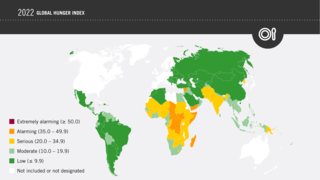Related Research Articles

Extreme poverty is the most severe type of poverty, defined by the United Nations (UN) as "a condition characterized by severe deprivation of basic human needs, including food, safe drinking water, sanitation facilities, health, shelter, education and information. It depends not only on income but also on access to services". Historically, other definitions have been proposed within the United Nations.

The Food and Agriculture Organization of the United Nations (FAO) is a specialized agency of the United Nations that leads international efforts to defeat hunger and improve nutrition and food security. Its Latin motto, fiat panis, translates to "let there be bread". It was founded on 16 October 1945.

The Group of Eight (G8) was an inter-governmental political forum from 1997 until 2014. It had formed from incorporating Russia into the Group of Seven, or G7, and returned to its previous name after Russia was expelled in 2014.

In politics, humanitarian aid, and the social sciences, hunger is defined as a condition in which a person does not have the physical or financial capability to eat sufficient food to meet basic nutritional needs for a sustained period. In the field of hunger relief, the term hunger is used in a sense that goes beyond the common desire for food that all humans experience, also known as an appetite. The most extreme form of hunger, when malnutrition is widespread, and when people have started dying of starvation through lack of access to sufficient, nutritious food, leads to a declaration of famine.

Food security is the availability of food in a country and the ability of individuals within that country (region) to access, afford, and source adequate foodstuff. The availability of food irrespective of class, gender or region is another element of food security. Similarly, household food security is considered to exist when all the members of a family, at all times, have access to enough food for an active, healthy life. Individuals who are food secure do not live in hunger or fear of starvation. Food insecurity, on the other hand, is defined as a situation of " limited or uncertain availability of nutritionally adequate and safe foods or limited or uncertain ability to acquire acceptable foods in socially acceptable ways." Food security incorporates a measure of resilience to future disruption or unavailability of critical food supply due to various risk factors including droughts, shipping disruptions, fuel shortages, economic instability, and wars.

Malnutrition occurs when an organism gets too few or too many nutrients, resulting in health problems. Specifically, it is "a deficiency, excess, or imbalance of energy, protein and other nutrients" which adversely affects the body's tissues and form. Malnutrition is not receiving the correct amount of nutrition. Malnutrition is increasing in children under the age of five due to providers who cannot afford or do not have access to adequate nutrition.

CGIAR is a global partnership that unites international organizations engaged in research about food security. CGIAR research aims to reduce rural poverty, increase food security, improve human health and nutrition, and sustainable management of natural resources.
The International Food Policy Research Institute (IFPRI) is an international agricultural research center founded in 1975 to improve the understanding of national agricultural and food policies to promote the adoption of innovations in agricultural technology. Additionally, IFPRI was meant to shed more light on the role of agricultural and rural development in the broader development pathway of a country. The mission of IFPRI is to provide research-based policy solutions that sustainably reduce poverty and end hunger and malnutrition.
Food politics is a term which encompasses not only food policy and legislation, but all aspects of the production, control, regulation, inspection, distribution and consumption of commercially grown, and even sometimes home grown, food. The commercial aspects of food production are affected by ethical, cultural, and health concerns, as well as environmental concerns about farming and agricultural practices and retailing methods. The term also encompasses biofuels, GMO crops and pesticide use, the international food market, food aid, food security and food sovereignty, obesity, labor practices and immigrant workers, issues of water usage, animal cruelty, and climate change.

The Global Hunger Index (GHI) is a tool that attempts to measure and track hunger globally as well as by region and by country, prepared by European NGOs of Concern Worldwide and Welthungerhilfe. The GHI is calculated annually, and its results appear in a report issued in October each year.

Food security is defined, according to the World Food Summit of 1996, as existing "when all people at all times have access to sufficient, safe, nutritious food to maintain a healthy and active life". This commonly refers to people having "physical and economic access" to food that meets both their nutritional needs and food preferences. Today, Ethiopia faces high levels of food insecurity, ranking as one of the hungriest countries in the world, with an estimated 5.2 million people needing food assistance in 2010. Ethiopia was ranked 92 in the world in Global Hunger Index 2020.

There were 795 million undernourished people in the world in 2014, a decrease of 216 million since 1990, despite the fact that the world already produces enough food to feed everyone—7 billion people—and could feed more than that—12 billion people.

The 2012 Olympic hunger summit was an international gathering on 12 August, the closing day of the 2012 Summer Olympics, held at 10 Downing Street London. The event was organised largely by the Department for International Development. It was co-hosted by Britain's prime minister, David Cameron, and by Brazil's vice president Michel Temer. The summit was attended by several high-profile athletes and by delegates from various national governments, the United Nations, NGOs and from the private sector.

Hunger in the United States of America affects millions of Americans, including some who are middle class, or who are in households where all adults are in work. The United States produces far more food than it needs for domestic consumption—hunger within the U.S. is caused by some Americans having insufficient money to buy food for themselves or their families. Additional causes of hunger and food insecurity include neighborhood deprivation and agricultural policy. Hunger is addressed by a mix of public and private food aid provision. Public interventions include changes to agricultural policy, the construction of supermarkets in underserved neighborhoods, investment in transportation infrastructure, and the development of community gardens. Private aid is provided by food pantries, soup kitchens, food banks, and food rescue organizations.

The Board for International Food and Agricultural Development (BIFAD) advises the United States Agency for International Development (USAID) on issues concerning agriculture, higher education in developing countries, and food insecurity. BIFAD was established and recognized by Title XII of the Foreign Assistance Act, and both the BIFAD board and Title XII recognize the critical role of U.S. land-grant institutions in food and agricultural security, domestically and abroad. BIFAD consists of seven board members appointed by the White House, four of whom must have been part of the US Academic community. The board's mission is to draw on the expertise and scientific knowledge of those in higher education to advise the US international assistance on the effect of domestic efforts to end food insecurity.

The Global Food Security Act of 2016, is a law introduced on March 24, 2015, in the 114th Congress by Representative Christopher Henry "Chris" Smith and on May 7, 2015, by Senator Robert Patrick "Bob" Casey Jr. (Pennsylvania-D), and signed by President Barack Obama on July 20, 2016.
Food security has been a major concern in India. In 2022, the Global Food Security Index ranked India at 68th out of the 113 major countries in terms of food security. In 2023, the Global Hunger Index ranked India at 111th out of 125 countries. According to United Nations, there are nearly 195 million undernourished people in India that make up a quarter of the world's undernourished population. In addition, roughly 43% of children in India are chronically undernourished. Though the current nutritional standards meets 100% of daily food requirements, India lags far behind in terms of a quality protein intake at 20%; this shortcoming can be alleviated by making available protein-rich food products such as soybeans, lentils, meat, eggs, dairy, etc. more readily accessible and affordable for Indian citizens. The Human Rights Measurement Initiative finds that India is operating at only 56.8% of its capacity based its economic power to ensure its citizens have adequate food security.

Mexico has sought to ensure food security through its history. Yet, despite various efforts, Mexico continues to lack national food and nutrition strategies that secure food security for the people. As a large country of more than 100 million people, planning and executing social policies are complex tasks. Although Mexico has been expanding its food and nutrition programs that have been expected, and to some degree, have contributed to increases in health and nutrition, food security, particularly as it relates to obesity and malnutrition, still remains a relevant public health problem. Although food availability is not the issue, severe deficiencies in the accessibility of food contribute to insecurity.
Hunger in Bangladesh is one of the major issues that affects the citizens of Bangladesh. The nation state of Bangladesh is one of the most densely populated countries in the world and home for more than 160 million people. It progresses immensely in the Human Development Index, particularly in the areas of literacy and life expectancy, but economic inequality has increased and about 32% of the population, that is 50 million people, still live in extreme poverty.

Sustainable Development Goal 2 aims to achieve "zero hunger". It is one of the 17 Sustainable Development Goals established by the United Nations in 2015. The official wording is: "End hunger, achieve food security and improved nutrition and promote sustainable agriculture". SDG 2 highlights the "complex inter-linkages between food security, nutrition, rural transformation and sustainable agriculture". According to the United Nations, there are around 690 million people who are hungry, which accounts for slightly less than 10 percent of the world population. One in every nine people goes to bed hungry each night, including 20 million people currently at risk of famine in South Sudan, Somalia, Yemen and Nigeria.
References
- ↑ "Feed the Future" . Retrieved 2023-10-16.
- 1 2 Portal, Michael (2014-06-16). "Feed the Future Initiative Saves Millions- BORGEN". BORGEN Magazine. Retrieved 2014-10-24.
- 1 2 3 4 5 6 "About | Feed the Future". Feedthefuture.gov. Retrieved 2013-11-25.
- ↑ "Food Security: Feed the Future | U.S. Agency for International Development". Usaid.gov. 2013-06-28. Retrieved 2013-11-25.
- 1 2 3 4 5 "General Background on Feed the Future Initiative" (PDF). Agsci.psu.edu. Archived from the original (PDF) on 2013-07-18. Retrieved 2013-11-25.
- ↑ "Population Clock". Census.gov. Retrieved 2013-11-25.
- 1 2 3 4 5 6 7 8 "The Obama Administration's Feed the Future Initiative" (PDF). Fao.org. Retrieved 2013-11-25.
- ↑ "Nutrition Indicators for Development". Fao.org. Retrieved 2013-11-25.
- ↑ "Feed the Future". Feedthefuture.gov. Retrieved 2023-10-16.
- ↑ "Feed the Future Initiative - Statement of Mr. Gerald Steiner, Executive Vice President, Sustainability and Corporate Affairs, Monsanto Company, before the House Foreign Affairs Committee, July 20, 2010". Monsanto. 2010-07-20. Archived from the original on October 25, 2014. Retrieved 2014-10-24.
- 1 2 3 Park, Alex (2013-09-23). "Is $7 Billion in Anti-Hunger Support Falling Through the Cracks?". Mother Jones. Retrieved 2014-10-24.
- ↑ Geller, Martinne (2011-09-20). "PepsiCo partnership to boost Ethiopian chickpeas". Reuters. Retrieved 2014-10-24.
- ↑ "Feed the Future Initiative reduces hunger and poverty, boosts incomes and nutrition around the world". High Plains / Midwest Ag Journal. 2014-06-09. Archived from the original on 2014-10-31. Retrieved 2014-10-25.